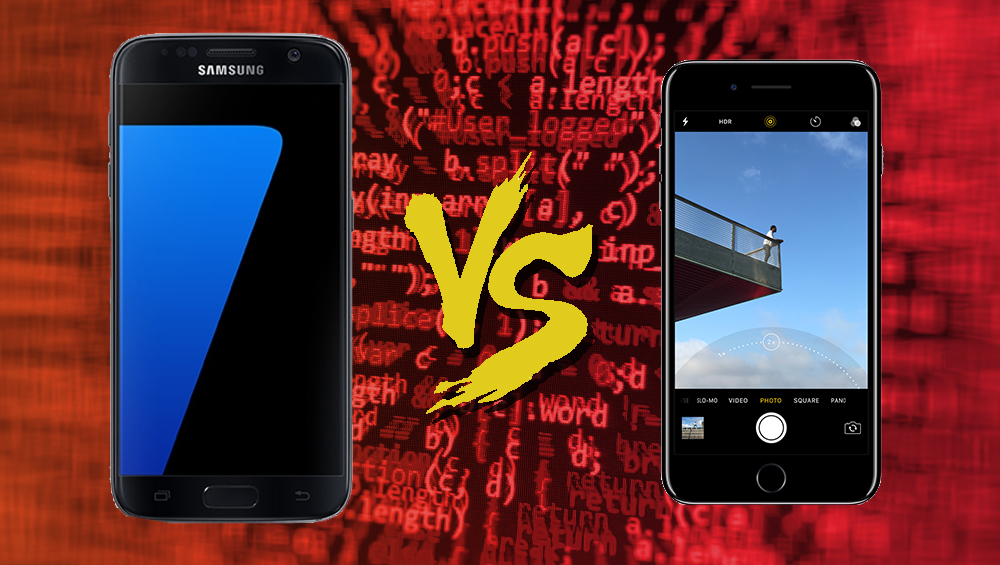Google Pixel vs Samsung Galaxy S7 vs iPhone 7
Which is the best phone for you?


With each new smartphone that hits the market comes a range of updated specifications and new features – meaning upgrading to a new device can be a daunting task.
Samsung released its Galaxy S7 flagship earlier in 2016, whilst Apple’s rival offering – the iPhone 7 – hit the shelves in September.
With Google, too, now throwing its new Pixel phone into the ring, the competition has never been so fierce – so we take a look below at three of the year’s biggest devices to help you decide which one is right for you.
Display
Google has raised its game with its latest premium smartphone, with the Pixel available in 5.0-inch (1080p) and larger 5.5-inch (QHD) variants. Both sizes sport AMOLED displays – meaning images are sharp and colours are vivid.
Similarly, the Galaxy S7’s super AMOLED display allows the phone’s screen to display deeper blacks and consume less power than alternative displays. Screen size measures 5.1 inches with a pixel resolution of 2560x1440.
The display on the iPhone 7 incorporates 3D Touch technology and the handset’s 4.7-inch screen provides a pixel resolution of 1334x750. Apple’s latest flagship retains the IPS LCD Retina screen – with an overhaul of iPhone display technology rumoured to be coming with next year’s iPhone 8.
Design
The Pixel, Galaxy S7 and iPhone 7 are all premium quality handsets – and it shows in all three.
ChannelPro Newsletter
Stay up to date with the latest Channel industry news and analysis with our twice-weekly newsletter
Google’s latest addition offers up a smart aluminium design that looks and feels the part. The upper third of the Pixel’s reverse is covered with a sleek glass panel – a feature that Google says allows for improved connectivity.
The iPhone 7 doesn’t stray too far from its predecessors in terms of its appearance – with the handset largely resembling the 6s. Apple has, though, improved the positioning of the antennae bands, shifting them to the upper and lower edges of the device.
A key change to this latest iPhone is the Home button redesign: Apple has ditched the physical button and opted for a pressure-sensitive version that provides haptic feedback. The handset is certified IP67 – meaning it is water-resistant for up to 30 minutes and also dust resistant.
The S7 is also IP67 classified – something the S6 unfortunately wasn’t – and the device largely sticks with the popular glass and metal design. Just like its predecessor, the underside of the phone is curved for improved handling.
Camera
The iPhone 7 sports a 12MP rear-facing camera with an improved f1.8 aperture – meaning users can capture improved images in situations of low lighting. The handset also boasts a 6-element lens, optimal image stabilisation, a new image signal processor and video capture at 4k.
The front-facing camera also receives an upgrade to 7MP and similarly performs better than its predecessors in low light environments.
The Galaxy S7, too, has a 12MP rear camera – but Samsung’s flagship has an f1.7 aperture rather than the f1.8 of the iPhone. The camera is also capable of 4k video capture and its dual-pixel sensor allows for a faster focus and greater accuracy.
The S7’s front-facing camera is 5MB – lower than the iPhone’s – but is, however, capable of recording video at 2k.
Considering the competition, it will come as no surprise that Google has also gone all-out on its cameras for its new premium offering.
The Pixel possesses a 12.3MP rear camera with f2.0 aperture and fast auto-focus. As expected, 4k video is also available. Its front camera also boasts an impressive 8MP and full HD video capture.
Performance
The Google Pixel is powered by a 2.1GHz Snapdragon 821 CPU and 4GB of RAM, making it a suitably quick and responsive smartphone.
The Galaxy S7 includes a Samsung Exynos 8890 chip which reduces battery drain thanks to its eight cores. Only four cores ever run simultaneously - but these consist of four 2.6GHz cores (for handling the larger tasks) and four at 1.6GHz (for processing smaller loads).
Apple included its quad-core A10 Fusion CPU with 64-bit architecture on the iPhone 7, along with an M10 motion co-processor. The company says this offers a 40 percent CPU and GPU performance increase on last year’s 6s – as well as a significant improvement in terms of battery life consumption.
Connectivity
Much has been made of Apple’s controversial decision to remove the traditional 3.5mm headphone jack in favour of the Lightning Port on the iPhone 7. This change means that users are unable to attach headphones and charge the device at the same time – a move perhaps designed to encourage people to purchase the company’s new wireless AirPods.
The Pixel and Galaxy S7 both retain the headphone jack but go their separate ways when it comes to USB connectivity: the S7 includes a micro-USB 2 port whereas Google’s device incorporates USB-C.
All three devices support Bluetooth 4.2 and Near Field Communication (NFC) technology. It should, however, be noted that Apple only allows the iPhone’s NFC chip to be used with its own Apple Pay electronic payment system.
Battery
Battery life is a major factor for many when deciding which handset to opt for – especially with the ever-expanding capabilities of smartphones.
The Galaxy S7 fares well in this department with its large 3000mAh battery, with recent tests conducted by consumer body Which? revealing that the cell is capable of lasting for 1,492 minutes of talk time or 677 minutes of internet usage.
Apple, however, seemingly opted for aesthetics over battery size – and it shows in the iPhone 7’s 1,960mAh battery. The same tests found it to last for just 712 minutes of call time and 615 minutes of internet use.
The Pixel sits somewhere in between with its 2,770mAh battery and – whilst all three devices support fast charging – Google says that its new smartphone can last seven hours from just 15 minutes of rapid charging.
Price and storage
As ever, price can often be a sticking point when deciding on a new smartphone – and, as demonstrated by all three of these premium offerings, they don’t come cheap.
You can bag yourself a 32GB Pixel for £599 – or a 128GB version for £699. The 5.5-inch iteration includes 128GB and a price tag of £819.
The iPhone 7 is available in 32GB, 128GB and 256GB variations – with prices sitting at £599, £699, and £799 respectively.
The Samsung Galaxy S7 is a little lower in price at £569 with 32GB of storage and, unlike the iPhone 7, its capacity can be expanded using a micro SD card.
Dan is a freelance writer and regular contributor to ChannelPro, covering the latest news stories across the IT, technology, and channel landscapes. Topics regularly cover cloud technologies, cyber security, software and operating system guides, and the latest mergers and acquisitions.
A journalism graduate from Leeds Beckett University, he combines a passion for the written word with a keen interest in the latest technology and its influence in an increasingly connected world.
He started writing for ChannelPro back in 2016, focusing on a mixture of news and technology guides, before becoming a regular contributor to ITPro. Elsewhere, he has previously written news and features across a range of other topics, including sport, music, and general news.
-
 The Race Is On for Higher Ed to Adapt: Equity in Hyflex Learning
The Race Is On for Higher Ed to Adapt: Equity in Hyflex LearningBy ITPro
-
 Google faces 'first of its kind' class action for search ads overcharging in UK
Google faces 'first of its kind' class action for search ads overcharging in UKNews Google faces a "first of its kind" £5 billion lawsuit in the UK over accusations it has a monopoly in digital advertising that allows it to overcharge customers.
By Nicole Kobie